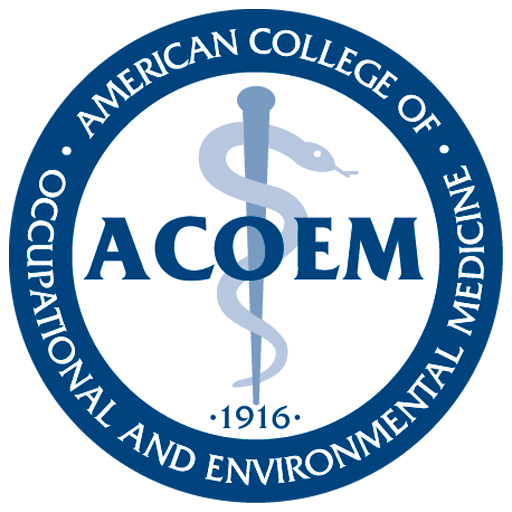
02: Care of the Ill or Injured Worker
Occupational skin conditions are those that occur at the workplace or worsen because of exposures there. Such exposures include:
- irritants, both physical (heat, water, radiation, friction) or chemical (acids, bases, metals, and other agents)
- allergens (certain metals and proteins such as animal dander)
- infections (fungal, viral, or bacterial)
Contact dermatitis comprises more than 95% of occupational skin diseases. The rest are acneiform diseases, cancer related, disturbances of pigmentation, infections, or allergic skin reactions. The most common types of contact dermatitis are allergic contact dermatitis, irritant contact dermatitis, and contact urticaria.
Epidemiology of Occupational Skin Diseases
Occupational Skin Disease (OSD) consistently accounts for approximately 35 to 40% of all occupationally acquired illnesses, affecting about one in every 1,000 workers. The incidence and prevalence of occupational dermatosis is slightly more among men (roughly 59%) than women (41%), with the highest rate occurring among 25- to 39-year-olds (about 39%). Nursing aides and orderlies, and janitors and cleaners, are the two types of workers with the most cases. They are involved in wet work: the direct and frequent exposure to water, as well as exposure of hands to wetness for more than two hours daily, is associated with irritant contact dermatitis. It also may make it easier for allergens to penetrate the skin.
Among the OSDs, allergic contact dermatitis is the largest cause of total temporary disability and is the costliest relative to occupational rehabilitation. Contact dermatitis (also known as eczema) has costs associated with both treatment and partial permanent disability.
Obtaining a comprehensive exposure history, including potential exposures at work and outside of work, can help in the management of dermatological conditions.
Occupational Skin Conditions: An Overview
Occupational skin conditions usually result from an exposures to irritant or allergic agents. The agent, its amount, length of and frequency of exposure, whether the worker uses personal protective equipment, and the individual’s susceptibility play a role in the development and severity of the condition. As the name implies, contact dermatitis—both irritant and allergic–results from exposure to an external agent that is able to penetrate the skin barrier.
Irritant contact dermatitis (ICD) is the most prevalent occupational skin condition. Acute ICD can result from exposure to strong acids or alkali, resulting in superficial—not deep—burns, and from direct exposure to ionizing radiation sources. Chronic ICD usually results from prolonged exposure to mild or weak irritants such as water (especially affecting health care workers, hairdressers, barbers, janitorial staff); cleaning agents, petroleum products, cutting fluids, abrasions, solvents, and metals (including arsenic and chromium); or mechanical friction, for example from wearing and removing surgical gloves. The process is accelerated with exposure to higher doses of the irritant agent or when one is exposed to a combination of irritants. Allergic mechanisms are not involved in the development of ICD.
In the acute phase, workers’ symptoms and clinical signs vary from transient redness and mild discomfort to skin sloughing and intense pain. Chronic presentation may show localized, well- demarcated areas of dryness, cracking, and gravitational dripping of the area involved. Some people have hyperpigmentation, thickening, lichenification, or cracking of the skin, and dryness is a prominent feature. Usually, a patient’s history and physical examination suffice to diagnose ICD; however, some clinicians request skin pricks, patch testing, or blood tests. These tests support irritant contact dermatitis diagnoses because they will be negative/normal.
Allergic contact dermatitis (ACD) occurs in genetically susceptible individuals who are sensitized to an allergen. Because allergens either come in direct contact with skin or are airborne, ACD usually affects only the exposed area of the body, typically the hands and to a lesser extent the face. Individuals with this condition may be diagnosed through patch testing. The worker likely presents with stinging or burning pain. Affected areas look raw and red, with papules (solid, elevated lesions of 0.5–1 cm or less in diameter that vary in color) and vesicles (elevated fluid-filled legions of under 0.5 cm).
Occupational contact urticaria (OCU) accounts for only 1 to 8% of reported cases of occupational skin disease. It can be seen in individuals who develop immunological skin reactions to plant and animal proteins and enzymes. This condition can affect workers in a wide variety of jobs. The worker is likely to develop itching, redness, edema, and wheals (elevated, itchy, fluid-containing lesions that usually disappear within a short period of time).
Evaluation of Occupational Skin Diseases
The first step in assessing occupational skin disease is to take a history. When you evaluate an individual with a skin condition, it is important to address occupational and non-occupational exposures: skin eruptions may, of course, have occupational sources but can also be related to systemic conditions such as infections or generalized allergies. A key question is to determine whether the eruption is work related or related to a systemic condition or generalized allergic reaction. Questions that may help in addressing both the diagnosis and causation include:
| Question | Description |
| Do you have preexisting medical conditions? | Some chronic medical conditions and their treatments can lead to skin eruptions (e.g., connective tissue disorders such as systemic lupus erythematosus), skin dryness (e.g., hypothyroidism), or thinning of the skin in certain areas (steroid injections) |
| Do you have a history of atopy? | Individuals with atopy may be at increased risk of developing irritant contact dermatitis. |
| Do you have other skin conditions? | Document any previous/existing skin conditions such as actinic keratosis, moles, eczema, or history of skin cancer. |
| Are you currently taking any medication? | Steroids and other immunosuppressive treatment and other treatments can have specific side effects on the skin. |
Inspection, palpation, and characterization of the lesion are essential components of the physical examination of the skin. If appropriate, a full-body skin examination is preferred, with documentation of findings, such as the presence or absence of moles, scars, or other features.
To identify the potential workplace source of a new skin condition, it is critical for clinicians to understand what a patient does for a living. Providers should establish when and where on the body the patient first noticed the skin eruption, what he or she was doing, whether the eruption spread, and how it looks and feels. ICD is usually localized and does not spread beyond the area of exposure; allergic reactions can spread beyond the area of exposure if they involve systemic response. It is helpful to ask patients to maintain a photo diary of lesions to help with further management of the case.
Prevention of Occupational Skin Diseases
Measures to prevent occupational contact dermatitis include elimination or replacement of the agent. Sometimes, engineering measures, such as automation of processes, are needed to remove the irritant. In the case of wet work, employers can reduce employees’ exposure by rotating tasks among all employees; providing personal protective equipment including barrier creams, gloves, after-work skin care and hydration products, and pH-balanced soaps; and administering preplacement screening for preexisting dermatitis. One of the most effective preventive methods is to train workers who use gloves or are involved in wet work about skin care, warning them of signs of skin problems, and ensuring the proper glove size.
Clinical Pearls
- Mechanical friction and dryness related to excessive washing and exposure to cold or repeated for repeated or prolonged periods of time can affect the integrity of the skin’s protective mechanisms, leading to increased susceptibility to reactions involving irritant or allergic
- Workers with atopic dermatitis may be at a higher risk of developing irritant contact dermatitis than those without
- Workers with ACD report severe itchiness and skin changes that include redness, papules, and vesicles. As a result, they often have difficulty returning to their pre-injury work even with appropriate personal protective Many, such as hairdressers, require elimination of exposure to the allergic agent, and some go on to change their craft.
- Chemical and sunburns are types of severe
- Using diagrams/illustrations to support documentation of the lesion, its distribution, and location can be helpful for follow-up
